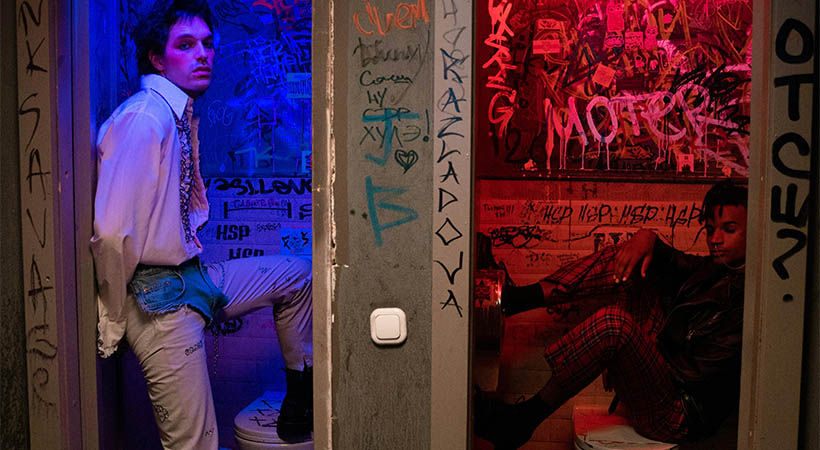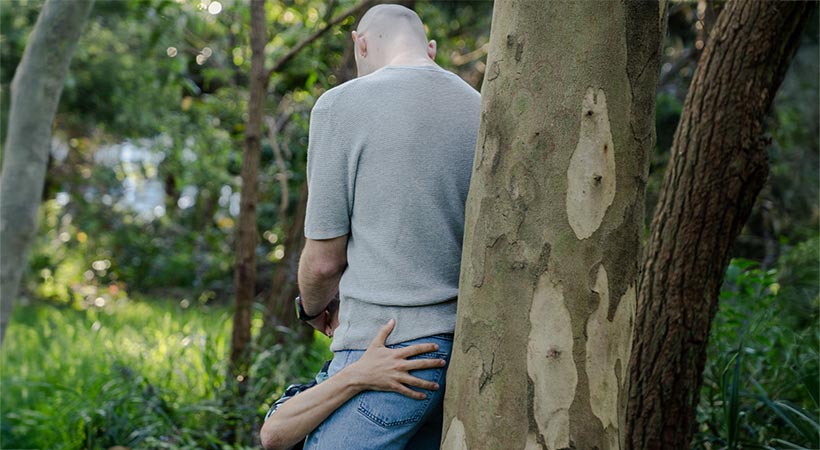Leaves crunch under heavy boots. A sideways glance at a burly man exiting the dilapidated toilet block. Eyes from a guy at the cracked basin. A nod from the pungent urinal. Subtle moans muffled by sneakers-on-tiles in the far cubicle.
The gay beat. A dark place with a sticky past, a shelter for anonymity, and the set for so many stories of connection and lust. A quintessential site in the history of gay culture in Australia.
We’ll take you to some of the popular local beats, tell you their histories and frequenters and show how significant they are for guys into guys from past to present.
What is a gay beat?
‘Gay beat’ is an Australian term for public places such as bathrooms and parks where gay, bisexual, and other men go to meet other guys for sex.
The word ‘beat’ parodies the regular path walked by police officers or sex workers. Gay and bi+ men adopted this to refer to places they would regularly attend for sex. For example, ‘The Wall’ was a popular beat in Darlinghurst, where guys and male sex workers would ‘cruise’ or pick up guys.
The thrill of sex at a gay beat
While public sex was not uncommon here, the beat often served as a meeting point for gay and bi+ men, who would go somewhere private to hook up. Darlinghurst’s ‘The Wall’, for instance, allowed for standing and posing, a way of meeting and picking up other men before the age of dating apps. Guys liked the appeal of a beat for the anonymity it provided, the thrill of having sex in public and the often more rugged clientele.
Beat-goers developed secret signals to communicate they were looking for sex. Queer communities have a rich history of these secret languages, such as the infamous gay slang Polari, lesbian carabiner signalling, and the handkerchief code. For beats, especially those in public toilets, one might tap their foot or swipe their hand under the stall to signal their intent to cruise.

History of the beat in Australia
The development of the gay beat may owe itself to the English practice of ‘cottaging’. It refers to sex between men in a public toilet, which historically resembled a small cottage. The first recorded ‘glory hole’ – a hole in between cubicles used to have anonymous anal or oral sex – traces back to 18th-century London.
In Australia, evidence of a gay beat in Naarm (Melbourne) on the corner of Swanston and Lonsdale streets dates back to the 1860s. A similar ‘haunt’ was recorded on Bourke Street in Gadigal (Sydney) by the scandal sheet ‘The Scorpion’ in 1895.
This history, however, is bleak and marked by discrimination against the men attended beats. Much of the evidence we have of early gay beats comes in the form of arrests and prosecutions of men under laws that criminalised homosexuality.
Today, while there is no specific offence for having sex in public, it can lead to charges related to indecent behaviour/exposure, which carry different penalties in each state and territory of Australia.
Given the risk, take care of your physical safety when attending beats. While less common now, violence can occur at beats. Take steps such as letting a friend know where you are going (or better yet, bringing them with you!), getting to know the area online beforehand, and not bringing valuables.

The significance of the gay beat
1. A private space for exploring sexuality
The beat, especially those in parks and toilets, enabled men young and old to engage in sex with other men in relative anonymity. Private stalls and gloryholes in hidden spots away from gay venues meant that guys could engage in oral and anal sex with less risk of being recognised and outed.
Digital exhibition Cruising the Bush tells a story about a beat called ‘the Teardrop’ in Western Sydney. The speaker talks positively of their exciting foray into cruising, suggesting that “casual encounters became a way for them to explore their sexuality” while living at home with their conservative parents.
In a podcast for West Australian museum Boola Bardip, Neil Buckley related how the beats in Boorloo (Perth) were not just used for sex but also enabled conversation and community building.
“And I remember at Swanbourne, there used to be a beat patrol by the Western Australia AIDS Council [now WAAC]. At Easter time, they used to come down, you know, with the bunny rabbit ears and…set up a barbecue.”
Like WAAC, many community organisations born out of the HIV epidemic also attended beats and sex-on-premises venues (SOPVs) to provide essential information about safe sex practices for men. These days, there are plenty of options to take charge of your sexual health at beats and SOPVs. Make sure you have an HIV prevention method (condoms, PrEP or an undetectable viral load) in place before attending a beat and test every three months. Find your nearest sexual health testing service with our interactive map.

3. A lasting legacy
Gay beats around Australia have impacted the way communities of gay and bi+ men have developed, interacted, connected, and derived pleasure. While the gay beat may have served a particular purpose in times before Gay Liberation and decriminalisation, their practices continue to be found in modern gay life. Nowadays, beats and cruisers can be found online with apps such as Sniffies, Squirt and BBRT.
Even with the rights gay and bi+ men benefit from today, beat culture continues to be the subject of controversy. In 2018, Neil Buckley donated a toilet door with a glory hole cut into it from Gosnells train station – a popular beat in Boorloo (Perth) – to the Western Australian Museum. While Buckley saw the exhibit as an important element of gay culture and the historic relationship between beats and the HIV epidemic, others called it ‘tacky’ and ‘insensitive’.
Despite its negative backlash, the gay beat is nonetheless an important piece of history for gay and bi+ men in Australia. If you’re keen on getting into the beat scene, check out Down An’ Dirty’s guide to navigating beats safely.
So, if you stumble across a cut-out gloryhole in a mangy public toilet, remember those who came before you!😉